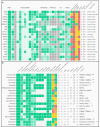Treating Duchenne Muscular Dystrophy: The Promise of Stem Cells, Artificial Intelligence, and Multi-Omics
- PMID: 35360042
- PMCID: PMC8960141
- DOI: 10.3389/fcvm.2022.851491
Treating Duchenne Muscular Dystrophy: The Promise of Stem Cells, Artificial Intelligence, and Multi-Omics
Abstract
Muscular dystrophies are chronic and debilitating disorders caused by progressive muscle wasting. Duchenne muscular dystrophy (DMD) is the most common type. DMD is a well-characterized genetic disorder caused by the absence of dystrophin. Although some therapies exist to treat the symptoms and there are ongoing efforts to correct the underlying molecular defect, patients with muscular dystrophies would greatly benefit from new therapies that target the specific pathways contributing directly to the muscle disorders. Three new advances are poised to change the landscape of therapies for muscular dystrophies such as DMD. First, the advent of human induced pluripotent stem cells (iPSCs) allows researchers to design effective treatment strategies that make up for the gaps missed by conventional "one size fits all" strategies. By characterizing tissue alterations with single-cell resolution and having molecular profiles for therapeutic treatments for a variety of cell types, clinical researchers can design multi-pronged interventions to not just delay degenerative processes, but regenerate healthy tissues. Second, artificial intelligence (AI) will play a significant role in developing future therapies by allowing the aggregation and synthesis of large and disparate datasets to help reveal underlying molecular mechanisms. Third, disease models using a high volume of multi-omics data gathered from diverse sources carry valuable information about converging and diverging pathways. Using these new tools, the results of previous and emerging studies will catalyze precision medicine-based drug development that can tackle devastating disorders such as DMD.
Keywords: Duchenne muscular dystrophy; artificial intelligence; cardiomyopathy; drug testing; iPSC disease modeling; single-cell technology.
Copyright © 2022 Vera, Zhang, Pang and Wu.
Conflict of interest statement
JW is a co-founder of Greenstone Biosciences. The authors declare that the research was conducted in the absence of any commercial or financial relationships that could be construed as a potential conflict of interest.
Figures


Similar articles
-
Electrophysiological abnormalities in induced pluripotent stem cell-derived cardiomyocytes generated from Duchenne muscular dystrophy patients.J Cell Mol Med. 2019 Mar;23(3):2125-2135. doi: 10.1111/jcmm.14124. Epub 2019 Jan 8. J Cell Mol Med. 2019. PMID: 30618214 Free PMC article.
-
Induced Pluripotent Stem Cells for Duchenne Muscular Dystrophy Modeling and Therapy.Cells. 2018 Dec 7;7(12):253. doi: 10.3390/cells7120253. Cells. 2018. PMID: 30544588 Free PMC article. Review.
-
Causes of clinical variability in Duchenne and Becker muscular dystrophies and implications for exon skipping therapies.Acta Myol. 2020 Dec 1;39(4):179-186. doi: 10.36185/2532-1900-020. eCollection 2020 Dec. Acta Myol. 2020. PMID: 33458572 Free PMC article.
-
De novo revertant fiber formation and therapy testing in a 3D culture model of Duchenne muscular dystrophy skeletal muscle.Acta Biomater. 2021 Sep 15;132:227-244. doi: 10.1016/j.actbio.2021.05.020. Epub 2021 May 25. Acta Biomater. 2021. PMID: 34048976
-
Stem cell therapies to treat muscular dystrophy: progress to date.BioDrugs. 2010 Aug 1;24(4):237-47. doi: 10.2165/11534300-000000000-00000. BioDrugs. 2010. PMID: 20623990 Review.
Cited by
-
High-confidence cancer patient stratification through multiomics investigation of DNA repair disorders.Cell Death Dis. 2022 Nov 26;13(11):999. doi: 10.1038/s41419-022-05437-w. Cell Death Dis. 2022. PMID: 36435816 Free PMC article.
-
Identification of Therapeutic Targets for Amyotrophic Lateral Sclerosis Using PandaOmics - An AI-Enabled Biological Target Discovery Platform.Front Aging Neurosci. 2022 Jun 28;14:914017. doi: 10.3389/fnagi.2022.914017. eCollection 2022. Front Aging Neurosci. 2022. PMID: 35837482 Free PMC article.
-
Advances in Duchenne Muscular Dystrophy: Diagnostic Techniques and Dystrophin Domain Insights.Int J Mol Sci. 2025 Apr 10;26(8):3579. doi: 10.3390/ijms26083579. Int J Mol Sci. 2025. PMID: 40332074 Free PMC article. Review.
-
How Can Proteomics Help to Elucidate the Pathophysiological Crosstalk in Muscular Dystrophy and Associated Multi-System Dysfunction?Proteomes. 2024 Jan 16;12(1):4. doi: 10.3390/proteomes12010004. Proteomes. 2024. PMID: 38250815 Free PMC article.
-
"If you cannot measure it, you cannot improve it". Outcome measures in Duchenne Muscular Dystrophy: current and future perspectives.Acta Neurol Belg. 2025 Feb;125(1):1-12. doi: 10.1007/s13760-024-02600-2. Epub 2024 Jul 31. Acta Neurol Belg. 2025. PMID: 39080230 Free PMC article. Review.
References
Publication types
Grants and funding
LinkOut - more resources
Full Text Sources

